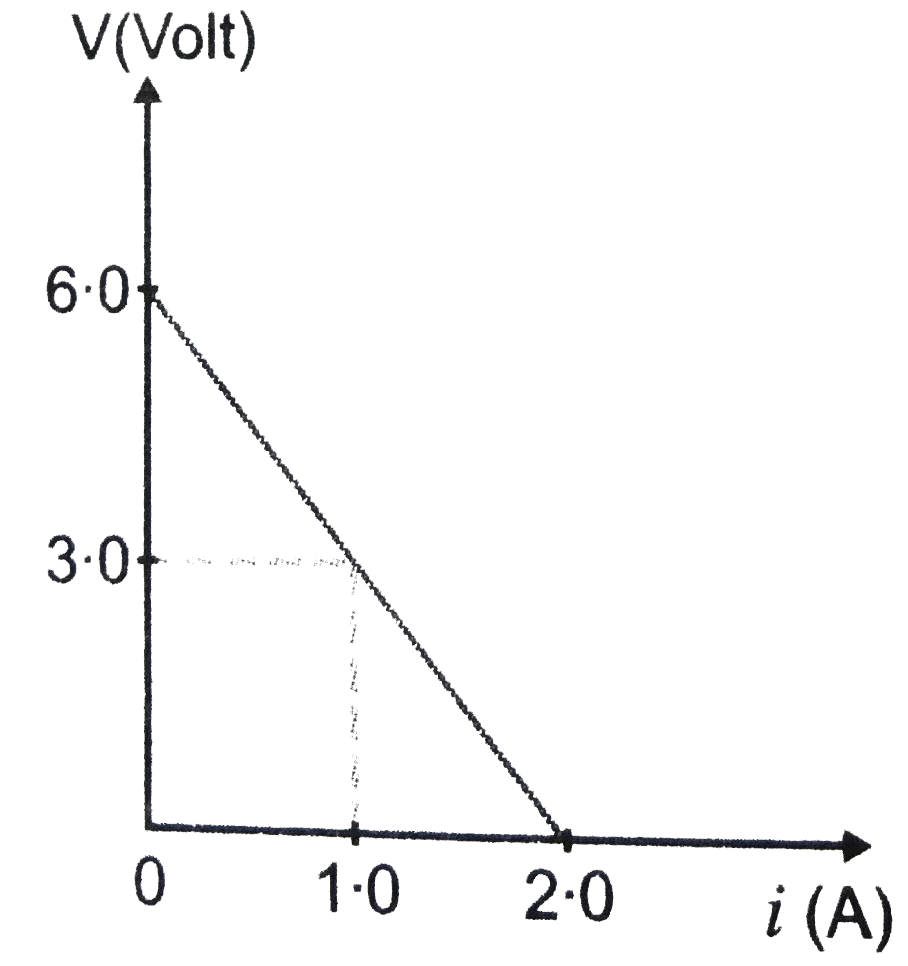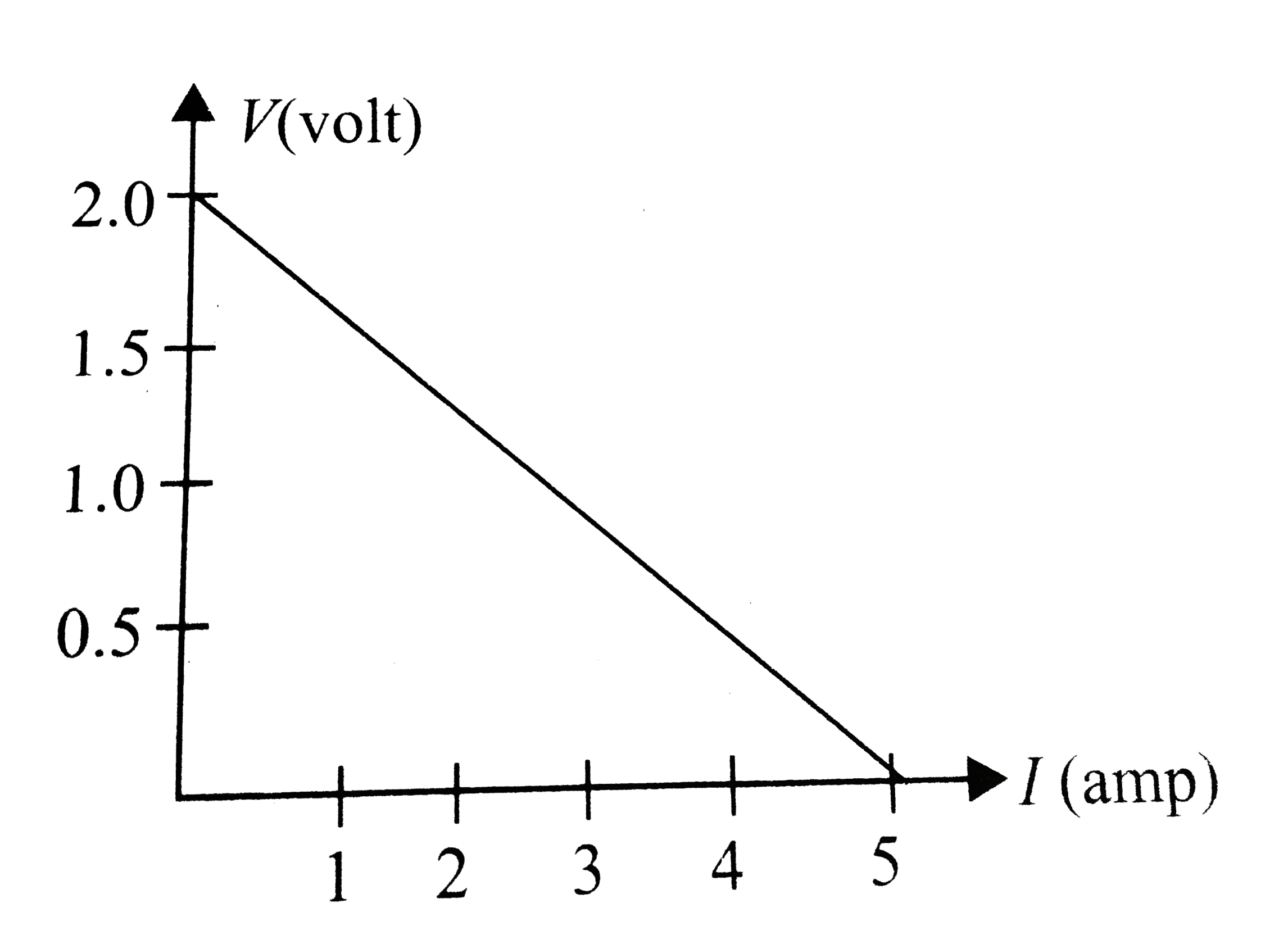The following graph shows the variation of terminal potential difference V, across a combination of three cells in series to a resistor versus the current I :
(i) Calculate the emf of each cell. (ii) For what current I, will the power dissipation of the circuit be maximum ?

(i) Let ∈ be emf and r the internal resistance of each cell. The equation of terminal potential difference V=eff−irnt becomes
V=3e−irnt…………(i)
where rnt is effective (total) internal resistance
From fig.when i=0,V=6.0V
∴From(i)6=3e-2 implies e=6/3=3Vi.e,emfofeachcell=2V<br>(ii)Formaxiμmpowerdissipation,theeffective∫ernalresistanceofcellsμstbeequal→externalresistance.Fromfig.,whenV=0,i=2.0A<br>thereforeEquation(i)gives0=3e-2.0(r_(nt) implies r_(nt)==(3e)/2.0=(3 times 2)/2.0=3 Omega<br>thereforeFormaxiμmpower,externalresistanceR=r_(nt)=3Omega<br>Current∈∘uiti=(3e)/(R+r_(nt))=(3 times 2)/(3 +3)=1.0A
(i) Thus, emf of each cell, e=2v and (ii) For maximum power dissipation, current in circuit = 1.0 A

Topper's Solved these Questions
- DC CIRCUITBook:VMC MODULES ENGLISHChapter:DC CIRCUITExercise:LEVEL-0 LONG ANSWER TYPE
Explore 3 Videos
- DC CIRCUITBook:VMC MODULES ENGLISHChapter:DC CIRCUITExercise:LEVEL-1 DAILY TUTORIAL SHEET-1
Explore 15 Videos
- DC CIRCUITBook:VMC MODULES ENGLISHChapter:DC CIRCUITExercise:LEVEL-0 SHORT ANSWER TYPE
Explore 9 Videos
- CURRENT ELECTRICITYBook:VMC MODULES ENGLISHChapter:CURRENT ELECTRICITYExercise:IN-CHAPTER EXERCISE-F
Explore 10 Videos
- DYNAMICS OF A PARTICLEBook:VMC MODULES ENGLISHChapter:DYNAMICS OF A PARTICLEExercise:JEE Advance (Archive) Level - II (SINGLE OPTION CORRECT TYPE )
Explore 31 Videos
Similar Questions
The plot of the variation of potential difference across a combination of three identical cells in series, versus current is as shown in figure. What is the emf and internal resistance of each cell?

View SolutionThe plot of the variation of potential difference across a combination of three identical cells in series, versus current is as shown in figure. What is the emf and internal resistance of each cell?

View SolutionIn an AC circuit with voltage V and current I, the power dissipated is
View SolutionFor a cell, the graph between the potential difference (V) across the terminals of the cells and the current I drawn from the cell is as shown in figure. Calculate the e.m.f. and the internal resistance of the cell.

View SolutionDraw a graph of potential difference (V) versus current (I) for an ohmic resistor.
View SolutionIn the circuit the potential difference across the capacitor is 10V. Each resistance is of 3Ω The cell is ideal. The emf of the cell is

View SolutionDraw a graph of Potential difference (V) versus Current (I) for an ohmic resistor.
View SolutionFor a cell, a graph is plotted between the potential difference V across the terminals of the cell and the current I drawn the cell. The emf and the internal resistance of the cell are E and r, respectively. Then

View SolutionDraw a. current versus load and b. current versus potential difference (across its two terminals) graph for a cell.
View SolutionThe figure shows a plot of terminal voltage 'V' verus the current 'I' of a given cell. Calculate from the graph (a) emf of the cell and (b) internal resistance of the cell.

View Solution